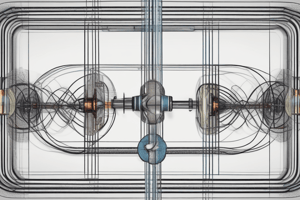Podcast
Questions and Answers
What is Coulomb's law primarily concerned with?
What is Coulomb's law primarily concerned with?
- The behavior of charges in a vacuum
- The relationship between electric charges and magnetic fields
- The motion of electric charges
- The force between two point charges (correct)
Which of the following correctly describes the relationship defined by Coulomb's law?
Which of the following correctly describes the relationship defined by Coulomb's law?
- Force is inversely proportional to the product of the charges
- Force is inversely proportional to the square of the distance between charges (correct)
- Force is directly proportional to the distance between charges
- Force is directly proportional to the product of the charges (correct)
What happens to the force between two like charges according to Coulomb's law?
What happens to the force between two like charges according to Coulomb's law?
- It remains constant regardless of distance
- It repels each other (correct)
- It increases with the distance between them
- It attracts each other
What is the constant of proportionality (k) in Coulomb's law dependent on?
What is the constant of proportionality (k) in Coulomb's law dependent on?
In a vacuum, what is the approximate value of the permittivity of free space ( ext{epsilon}_0)?
In a vacuum, what is the approximate value of the permittivity of free space ( ext{epsilon}_0)?
What is the effect of distance on the force between two point charges as described by Coulomb's law?
What is the effect of distance on the force between two point charges as described by Coulomb's law?
For two different point charges in free space, if the distance between them is halved, how does the force between them change?
For two different point charges in free space, if the distance between them is halved, how does the force between them change?
Which of the following best represents the mathematical expression of Coulomb's law?
Which of the following best represents the mathematical expression of Coulomb's law?
Flashcards are hidden until you start studying
Study Notes
Charges and Their Interaction
- Two types of electric charges exist: positive (protons) and negative (electrons).
- Like charges repel each other, while unlike charges attract each other.
Historical Context
- Charles Coulomb conducted the first measurement of electric force in 1874.
- His experiments led to the formulation of Coulomb's law.
Coulomb's Law
- Coulomb's law quantifies the force between two point charges.
- The force (F) is directly proportional to the product of the magnitudes of the charges (q1 and q2).
- The force is inversely proportional to the square of the distance (r) between the charges.
- Mathematically expressed as:
- F ∝ (q1 * q2) / (r²)
- F = k * (q1 * q2) / (r²)
Force Characteristics
- F is the magnitude of the mutual force acting on the charges.
- Force acts along the line that connects the two charges.
- 'k' represents the constant of proportionality.
Coulomb's Constant
- The value of 'k' varies with the medium between charges and the unit system used.
- For free space and SI units:
- ( k = \frac{1}{4 \pi \epsilon_0} )
- ( \epsilon_0 ) is the permittivity of free space, valued at ( 8.85 \times 10^{-12} , \text{Nm}^2/\text{C}^2 ).
- Substitute to find ( k = 9 \times 10^9 , \text{N m}^2/\text{C}^2 ).
Coulomb's Force in Free Space
- The expression for Coulomb's force in free space becomes:
- ( F = \frac{1}{4 \pi \epsilon_0} \cdot \frac{q1 \cdot q2}{r^2} )
Studying That Suits You
Use AI to generate personalized quizzes and flashcards to suit your learning preferences.




